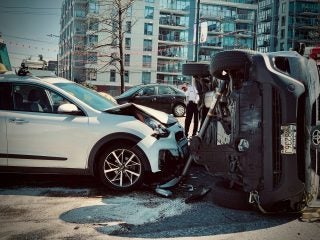According to the World Health Organization, approximately 1.3 million people die every year as a result of road traffic collisions.
So, it’s of the utmost importance that you remember to always drive safely and follow the rules of the road.
But what is the biggest cause of car accidents?
94% of Accidents Involve Human Error
While things like poor weather conditions and vehicle defects can cause car accidents, the biggest cause of car accidents is undoubtedly human error.
In fact, according to the U.S. National Highway Traffic Safety Administration’s National Motor Vehicle Crash Causation Survey, human error accounts for a whopping 94% of car accidents.
Also, most accidents are caused by just one at-fault driver, although many do happen as a result of multiple at-fault drivers.
While the numbers behind car crashes are sure to change from one state to another, the three main human-error causes of car accidents are speeding, driving while under the influence of alcohol, and distracted driving.
Let’s take a look at some of the most important statistics for each of those three causes.
1. Speeding Stats
According to the U.S. Insurance Institute for Highway Safety, between 2006 and 2015, 108,554 car accidents were caused by drivers speeding.
Interestingly, out of approximately 10,000 speed-related fatalities that happened in 2015, 48% occurred on roads where the speed limit was 55 mph or higher. That’s not surprising when you consider that, according to the World Health Organization, every 1% increase in speed produces an increase of 4% in the risk of fatal collisions.
Furthermore, the fatality risk for pedestrians who are hit by the fronts of cars increases by 4.5% from a car traveling at 50 km/h to one traveling at 65 km/h.
And the fatality risk for the occupants of cars speeding at 65 km/h that are involved in side-impact collisions is a staggering 85%.
2. Drunk Driving Stats
According to the U.S. Center for Diseases Control and Prevention, every single day, 28 people die in the United States due to drunk driving. That’s the equivalent of one death occurring every 53 minutes.
Hundreds of thousands of people have died in the U.S. alone over the last decade due to people getting behind the wheel of a vehicle while under the influence of alcohol. And according to the WHO, there’s a greater risk of a car accident happening even when drivers have low levels of blood alcohol concentration. The risk increases significantly with the more alcohol a driver has in his or her system. When a driver’s BAC is 0.04 g/dl, there is a much higher chance of a serious car accident occurring.
3. Distracted Driving Stats
We’ve seen how human error is more likely to happen when drivers speed or drive while drunk, but distracted driving can be just as devastating.
When drivers do things like text, talk on cell phones, eat, adjust the radio, light a cigarette, or chat to passengers while driving, they’re not 100% focused on the road.
According to the U.S. National Highway Traffic Safety Administration, between 2010 and 2014, distracted drivers caused almost 4.5 million car crashes in the United States alone.
Cell phones are one of the biggest contributory causes of distracted driving, which in turn, causes distracted drivers to be more prone to making errors, such as slower reaction times when it comes to braking and reacting to traffic signals.
Distracted driving also makes it more difficult for drivers to stay in the correct lane and maintain the proper following distances.
According to the WHO, drivers who use cell phones while driving are around four times more likely to be involved in a car crash.

















